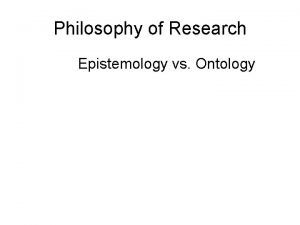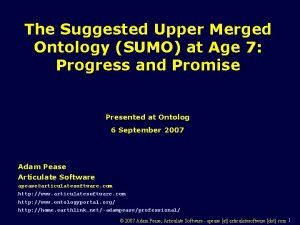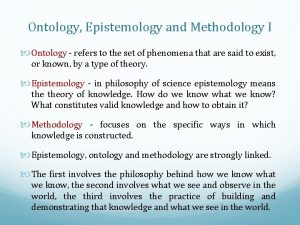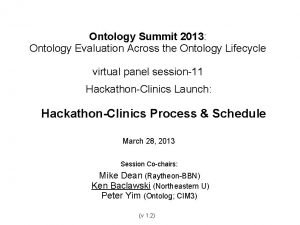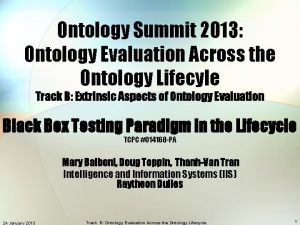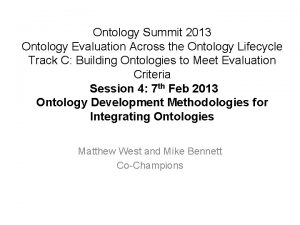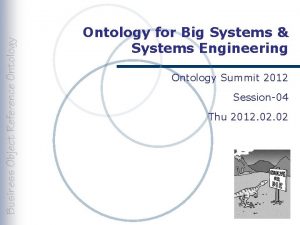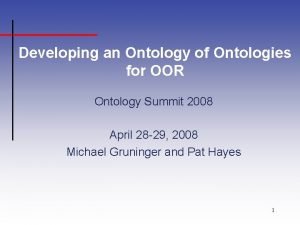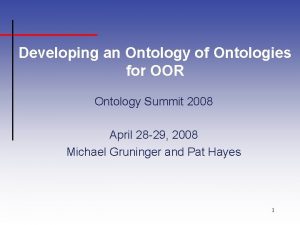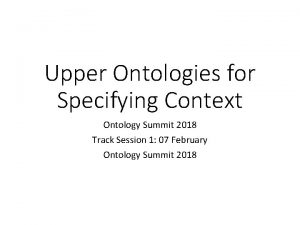Ontologies and engineering analysis David Leal Ontology Summit












- Slides: 12

Ontologies and engineering analysis David Leal Ontology Summit 2012 2 nd February 2012

What is engineering analysis? • Analysts look at the physics – systems engineers – want something to do X – designers – propose a way of doing X – analysts – predict whether or not it will do X • There is a design analysis loop – design optimisation is part of analysis • Certification is increasingly based on analysis – there are many things that are to expensive to make and break • maybe the demarcation line between what analysts do and what systems engineers do is whether or not physical laws are involved

e. g. crash test simulation • Non-linear geometry, non-linear material behaviour, fluid flow, contact • Decisions about the level of idealisation

Distinctive problems of engineering analysis • Lots of data – gigabytes of data in a single analysis – terabytes within a sequence of analyses for a particular objective • Safety critical – you may be asserting that a product will not break in an event that you cannot replicate in a test rig • some accidents you don t want to replicate • replicating 50 years of life takes a long time • You get asked “how do you know the answers are right” • Ultimately there is an audit trail back to tests – material tests – validation of analysis methodologies

Engineering analysis is a “cottage industry” • Much of it is not routine – you do not necessarily know the analysis steps you will need to carry out before you start • Done by small teams of opinionated people who do not take kindly to PLM (Product Lifecycle Management) systems – a wide range of different disciplines – fatigue, thermal, fluid dynamics, high strain rates, creep, radiation • Work can be subcontracted – analyses of components may be carried out to OEM requirement by the component supplier • Standardisation of analysis data has not taken off – data is much more complicated than geometry – much of the interesting information is about the processes

Engineering analysis is a “cottage industry” • Much of it is not routine – you do not necessarily know the analysis steps you will need to carry out before you start • Done by small teams of opinionated people who do not take kindly to PLM (Product Lifecycle Management) systems – a wide range of different disciplines – fatigue, thermal, fluid dynamics, high strain rates, creep, radiation • Work can be subcontracted – analyses of components may be carried out to OEM requirement by the component supplier • Standardisation of analysis data has not taken off – data is much more complicated than geometry – much of the interesting information is about the processes

Lots of activities, lots of players

International Association for the engineering analysis community • NAFEMS North American Work Session on the Management of Simulation Data "Take Control of Your Analysis and Simulation Data", 27 th September 2007, Troy, Michigan (USA). – This session lead to the formation of the North America based NAFEMS Simulation Data Management Working Group. • NAFEMS European Conference on “Simulation Process and Data Management” (SDM), 15 th and 16 th November 2011, Munich, Germany.

Problems • An engineering analysis ends with: – a text analysis report containing conclusions – some pretty pictures in the report – terabytes of data scattered here and there across servers, which theoretically justify the conclusions • What data is archived with the report? – How do you check the quality of the analysis process? • Hw do you do another analysis of the same component? – often you start again from the product geometry in the PLM system • Has anybody ever done a similar analysis before? – who was it, can the do it again, how long did it take? – did they get the right answer?

Doing better is not difficult • The big files are 99. 99% “images” of fields, and 0. 01% semantics – Inside the files there are scraps of text that identify parts, features, materials, states, etc. – Inside the files there is limited information about, when, who, and what software (but nothing about why the file was created) • Create a ontology for analysis – parts, features, materials, states, etc. • analysis is 4 D – fields are objects • Make the semantics inside the files visible as RDF – the big files are mostly descriptions of the fields • Record the analysis activities – the files are inputs and outputs

Metrics • Quality metrics – mesh shapes, field discontinuities, etc. • Ranges of values in fields – are displacements consistent with a geometrically linear analysis? – are stresses consistent with a linear elastic analysis? • An ontology of metrics will enable them to be recorded – metrics become annotation of the files, and are then readily accessible

Decisions • Decisions are based on statements not “images” – e. g. the maximum surface stress on a weld – e. g. the limit state load – the statements should be explicit and linked to the data files from which they are derived • Decisions are activities – analysis involves many decisions • that a mesh is good enough • that a boundary can be regarded as rigid • that the temperature difference across this wall can’t be more that X – record the analysis decision as a statement – record the activity of making the decision • who was responsible and when
 Open biomedical ontologies
Open biomedical ontologies Fernando leal pereira dos santos
Fernando leal pereira dos santos Fernando leal pereira dos santos
Fernando leal pereira dos santos Leal ambiental
Leal ambiental Jose becerril leal
Jose becerril leal Epistemology vs ontology
Epistemology vs ontology Objectivism vs constructivism ontology
Objectivism vs constructivism ontology Ontology, epistemology, axiology
Ontology, epistemology, axiology What is an ontology
What is an ontology Suggested upper merged ontology
Suggested upper merged ontology Protege user guide
Protege user guide Ontology epistemology methodology
Ontology epistemology methodology Ontology alignment
Ontology alignment






